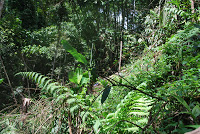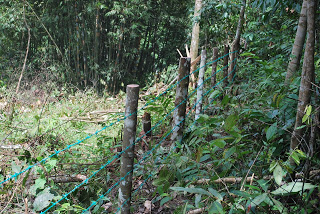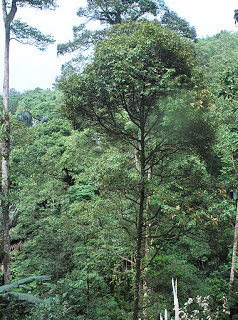One of my goals in developing Helang Lui is to provide a practical example of how land can be developed maximizing existing features on the land. Alhamdulillah, I was presented with an opportunity to work on a project to develop a property into a retreat, a place where a family can enjoy their weekends in as natural setting as possible in relative comfort. The property is located in Ulu Langat with a size of 3.1 acres on a hillside, with some sections of steep terrain.
Before I started on this project, I had several good conversations with the owner to understand what his goal and vision for the land was. It was also important for me to understand how the owner feels about this property as this will influence the direction of the development. Prior to my involvement, he had met with others and the main idea had mainly been to bulldoze the land to clear it and then start anew. I tend to shy away from this concept of land razing, especially land that has decades worth of trees. You can discover many wonderful treasures and in this instance, we found durian, cempedak, manggis, petai, kerdas and jering trees as well as plants and trees that can be used for various purposes such bertam and buloh and also other trees that can produce good lumber as well as provide shade and beautify the land.
 |
| Steep boundary line |
The first step was to perform a site survey, to see what is on the land, the contour and the terrain. Getting to the property was a workout as it required about 15 minutes of high grade hiking and walking within the property was another workout but definitely well worth it. The site survey provided great insights as well as realization of how many beautiful trees there are as well as what types of trees was present as well as what produce can be obtained. Bull dozing the land would have caused a lost of many of these trees.
Following the site survey and further discussion, a project plan was developed. This is key to ensure that I know what I need to do for this project as well as will enable me to create a project budget as we proceed.
The first phase was to clear the boundary lines to enable the owner to have a clear sight of the boundaries. During this phase, trees that were not designated to be retained were chopped. Locating the boundary markers was essential, and armed with the land plan, we were able to locate the markers, although getting to some of the markers was a challenge.
 |
| Sloping boundary, a challenge to fence |
The second phase is to fence the property. This is important to delineate the property and to discourage encroachment as well as unauthorized access. Due to the previous state, the property had the appearance as a forest and there were signs of unauthorized access as well as rubber tapping activities.
 |
| Wood fence post with green barbed wire |
A major challenge in this phase was to come out with a fencing plan that will maximize on what was available on the land and minimize what needed to be brought in due to no road access to the property, just a pathway. As such, the fence post was produced from the trees felled and green barbed wire is used. The choice of the fence post was mainly due to two factors:
- Difficulty in bringing construction materials
- Cost

Metal fence post was not a consideration due to the attractiveness to thieves who would steal them for scrap metal. The barbed wired were brought in on the motorcycle – albeit it had to have all-terrain tires on it.
Throughout the two phases, pathways were created to ease access on the property, especially in light of the hilly and steep terrain in sections of the land. With the season rains, terrain challenge and farm commitments, the fencing work should be completed in by end of this week. I am looking forward to the completion of this phase and I can already see how the appearance of the land has changed, providing clarity and clear demarcation of boundaries.
The remaining phases are :
- The third phase is to enable a water supply to the property.
- The fourth phase is to create a rest area.
- The fifth phase is to clear the remaining property off unwanted plants and trees.
- The sixth phase is to perform plant maintenance.

For the third phase, providing water supply, it is clear that there is a nearby water source as pipes have been found along the stream that passes this property. It is anticipated that we will embark on this next phase in January with a survey the water source as well as the possible routes for the laying of the polypipe as well as solution to enable water supply to the highes possible level on the land. There are many factors to consider, another challenge in the development of this property.
From here on, with scheduled maintenance, this beautiful property can become a great weekend retreat. I look forward to the completion of this project 🙂
 Due to the shape of the pond, it has caused for access to the back portion of the farm a bit inconvenient. The decision was made to build a bridge across.
Due to the shape of the pond, it has caused for access to the back portion of the farm a bit inconvenient. The decision was made to build a bridge across.  This bridge will also make for a pleasant chilling out place, with a nice view. There will be additional finishing touches to be added, but this will be done after the fish holding area is completed.
This bridge will also make for a pleasant chilling out place, with a nice view. There will be additional finishing touches to be added, but this will be done after the fish holding area is completed. To improve the harvesting process, a fish holding area is being created to enable the fish to be kept alive during the harvesting process.
To improve the harvesting process, a fish holding area is being created to enable the fish to be kept alive during the harvesting process.  This will enable for the fish to be “Categorized” according to their grades easier as well as enable the buyers to make their selections. As with many of the projects, the aesthetic aspects are not forgotten. Access to the holding area is also made easier with the construction of steps.
This will enable for the fish to be “Categorized” according to their grades easier as well as enable the buyers to make their selections. As with many of the projects, the aesthetic aspects are not forgotten. Access to the holding area is also made easier with the construction of steps.












